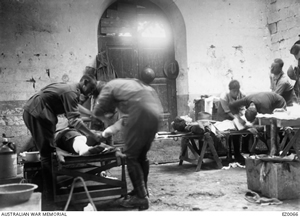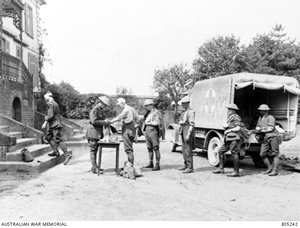Science Stage 4
Overview

Members of the Australian Army Medical Corps dressing the wounds of Australian soldiers in Becourt Chateau during the battle of Pozieres.
©Public Domain (AWM EZ0066)
Students research an example of how changes in scientific knowledge have contributed to finding a solution to a human health issue in the context of the First World War. Students recount how evidence from a scientific discovery has changed understanding and contributed to solving a real world problem, for example, animal or plant disease, hygiene, food preservation, sewage treatment or biotechnology.
Teaching and learning activities

Injured Australian soldiers being injected by a member of the 5th Division Medical Corps with anti-tetanus serum outside the Medical Dressing Station established at the White Chateau, August 1918
©Public Domain (AWM E05242)
In the context of the First World War disease and infection, how did scientific discoveries significantly change people’s understanding of the world?
Context
During the First World War many soldiers died from diseases and infections. Changes in scientific knowledge helped to reduce deaths caused by disease and infections.
Students:
a. Research an example of how changes in scientific knowledge have contributed to finding a solution to a human health issue.
Teacher directs students to the following pages on the BBC website:
How were soldiers injured in the First World War? OR
How did the First World War change the way we treat war injuries today?
Students are given a list of human health issues that affected soldiers in the First World War.
Teacher provides one scaffolded answer, for example:
Health Issue: High death rate due to infection from gunshot wounds
Change in knowledge and understanding: Disease caused by microorganisms
Solution: Antiseptics
Students research:
-
a human health issue, for example, patients dying from infection after surgery
-
a change in scientific knowledge and understanding, for example, the discovery of antiseptics by Lister
-
a solution to the human health issue, for example, carbolic acid spray and other bacteria killing chemicals used.
Teacher places headings of examples of changes in understanding on noticeboards around the room including:
-
antiseptics
-
anaesthetics
-
blood transfusions
-
vaccinations
-
X-rays.
Students write the name of the disease they researched on a post-it note and place the note under the relevant heading.
Students:
b. Recount how evidence from a scientific discovery has changed understanding and contributed to solving a real world problem, such as animal or plant disease, hygiene, food preservation, sewage treatment or biotechnology.
Teacher sets up a cooperative jigsaw. Students research one of the scientific discoveries: antiseptics, anaesthetics, blood transfusions, vaccinations, X-rays.
Students return to their home groups to discuss findings, including the scientific discovery, the change in understanding and the real world problem that was solved during the First World War.
Resources:
Medical treatment during World War 1
Diseases Among Prisoners of War, Table 23: Admissions for 23 selected causes among German prisoners of war in enclosures, European Theater of Operations, U.S. Army, for 6-week period ending 15 June 1945 from Extract from Medical Department, United States Army
Learning concepts
These additional questions can be used for discussion or further investigations.
Challenge
What challenges faced medical staff in the treatment of injuries and disease during the First World War?
Change
How did changes in scientific knowledge contribute to finding a solution to First World War human health issues?
How did the First World War change the way injuries and medical conditions are treated today?
Caring
What service personnel cared for injured soldiers? What facilities and services were provided for treating injured personnel?
Community
How has the community benefited from changes in scientific knowledge in the First World War?
Syllabus links
SC4-9WS presents science ideas, findings and information to a given audience using appropriate scientific language, text types and representations
SC4-15LW explains how new biological evidence changes people’s understanding of the world
LW4 Scientific knowledge changes as new evidence becomes available, and some scientific discoveries have significantly changed people's understanding of the world. (ACSHE119, ACSHE134)